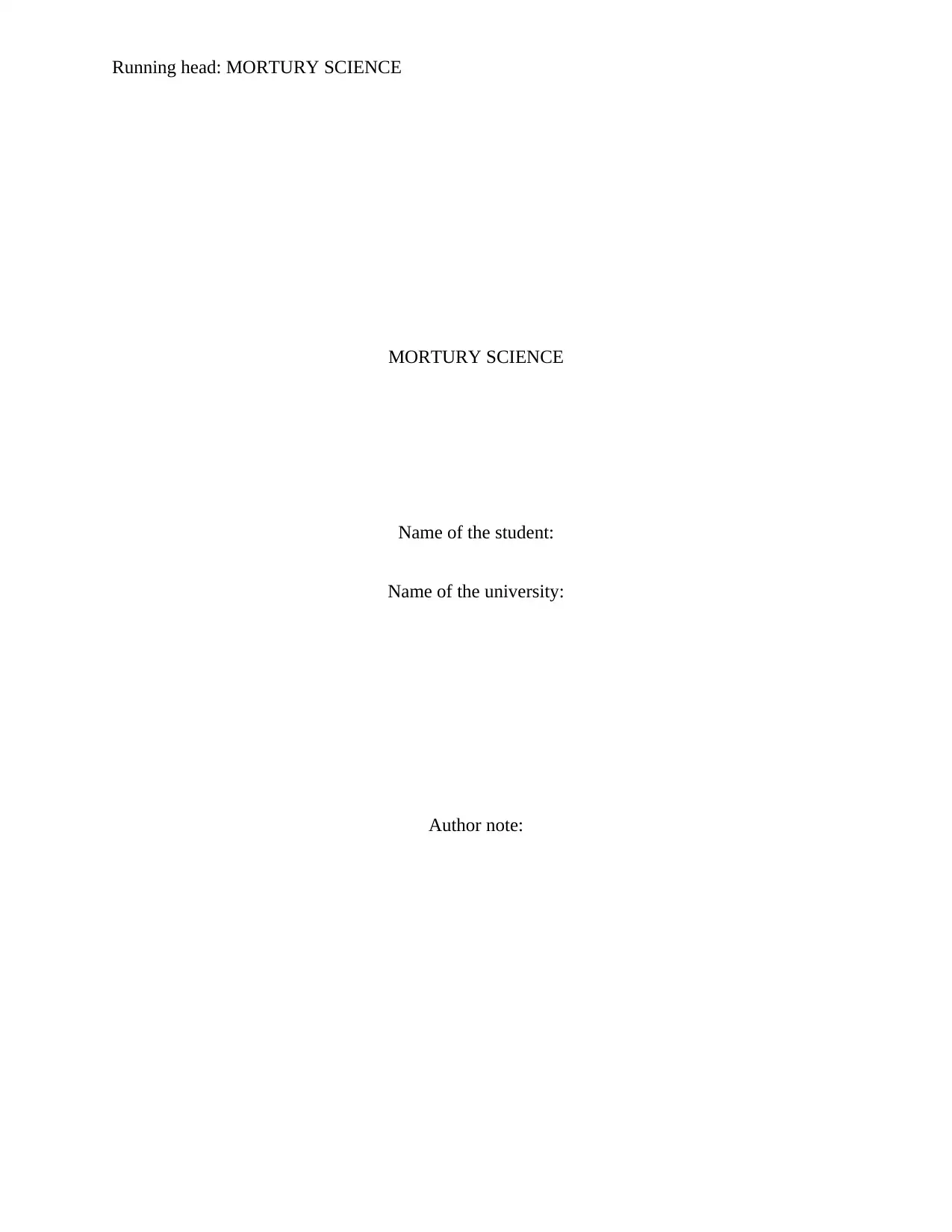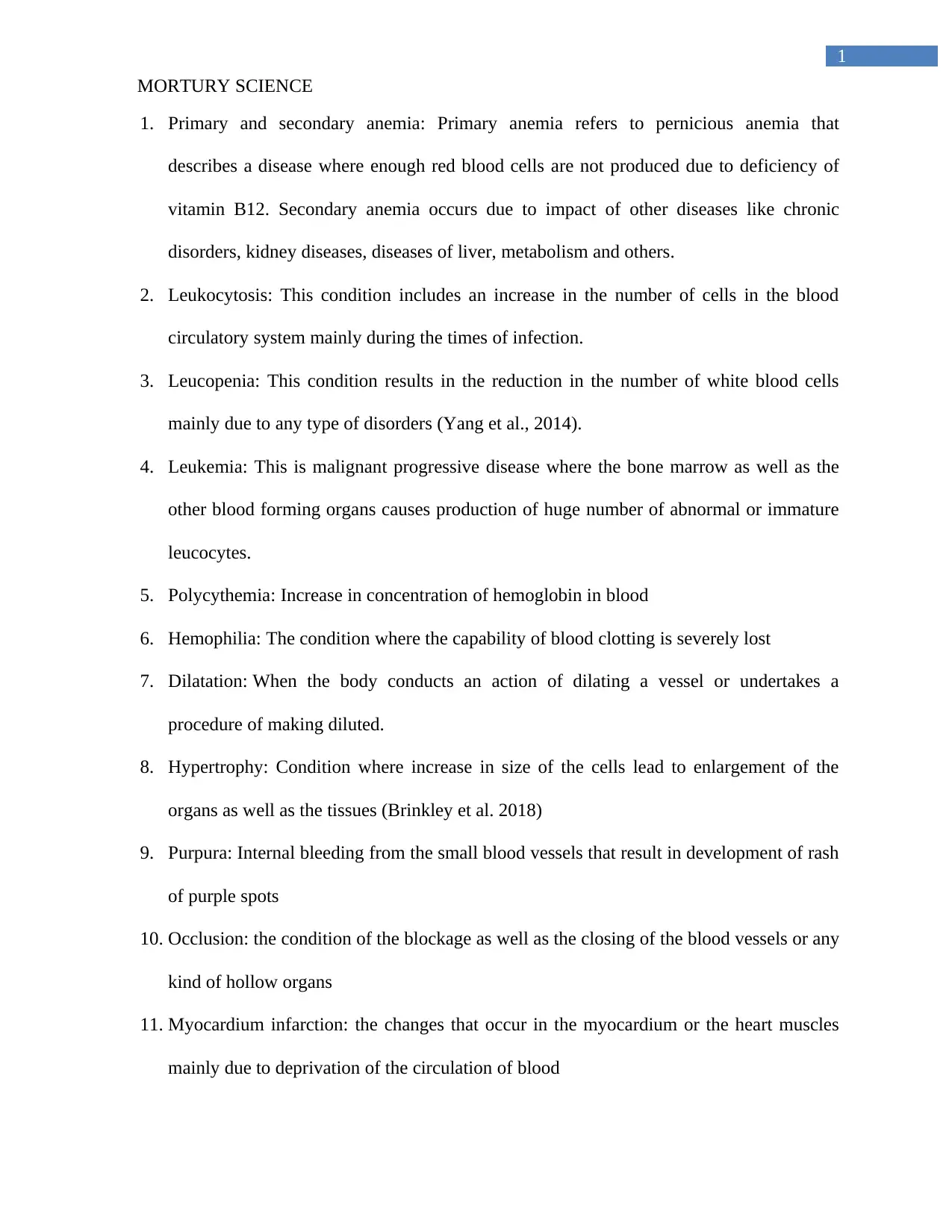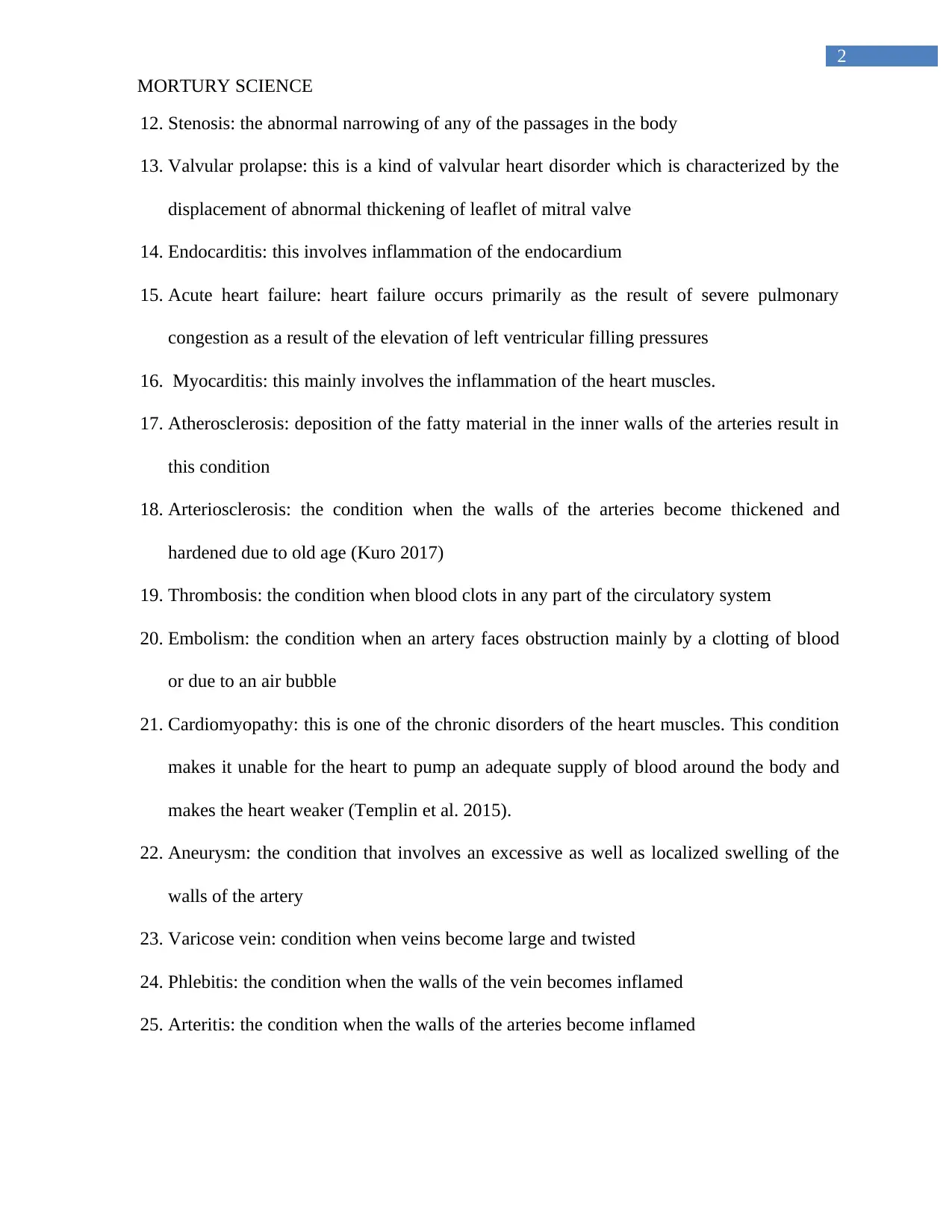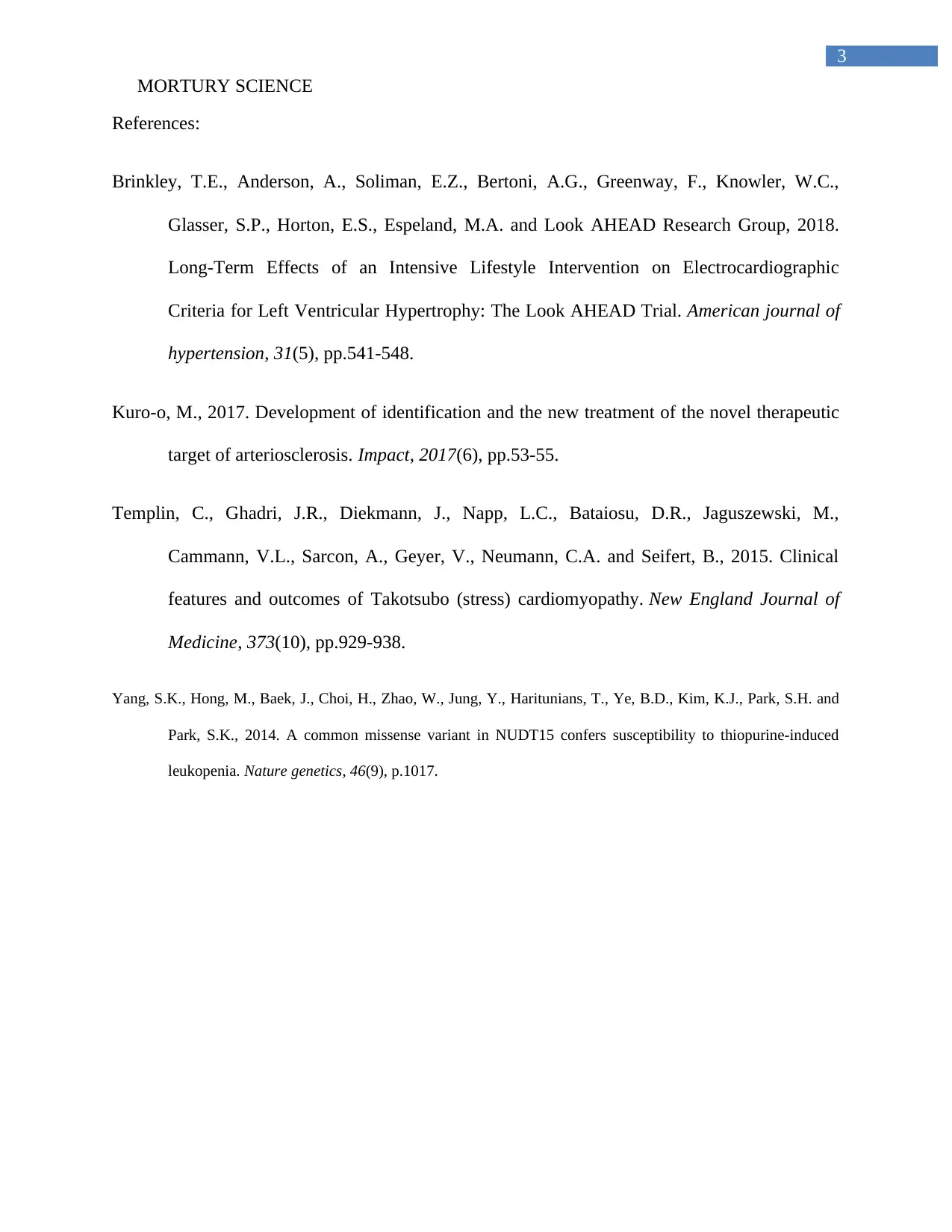Mortuary Science: Definitions of Anemia, Leukocytosis, and More
VerifiedAdded on 2023/06/10
|4
|855
|217
Homework Assignment
AI Summary
This assignment provides definitions for a range of terms relevant to mortuary science, covering hematological conditions such as primary and secondary anemia, leukocytosis, leucopenia, leukemia, and polycythemia, as well as hemostatic disorders like hemophilia. It also defines pathological states including dilatation, hypertrophy, purpura, occlusion, and myocardial infarction. Furthermore, the assignment elucidates cardiovascular terms such as stenosis, valvular prolapse, endocarditis, acute heart failure, myocarditis, atherosclerosis, arteriosclerosis, thrombosis, embolism, cardiomyopathy, aneurysm, varicose vein, phlebitis, and arteritis. This comprehensive list serves as a foundational reference for students studying mortuary science.

Running head: MORTURY SCIENCE
MORTURY SCIENCE
Name of the student:
Name of the university:
Author note:
MORTURY SCIENCE
Name of the student:
Name of the university:
Author note:
Paraphrase This Document
Need a fresh take? Get an instant paraphrase of this document with our AI Paraphraser

1
MORTURY SCIENCE
1. Primary and secondary anemia: Primary anemia refers to pernicious anemia that
describes a disease where enough red blood cells are not produced due to deficiency of
vitamin B12. Secondary anemia occurs due to impact of other diseases like chronic
disorders, kidney diseases, diseases of liver, metabolism and others.
2. Leukocytosis: This condition includes an increase in the number of cells in the blood
circulatory system mainly during the times of infection.
3. Leucopenia: This condition results in the reduction in the number of white blood cells
mainly due to any type of disorders (Yang et al., 2014).
4. Leukemia: This is malignant progressive disease where the bone marrow as well as the
other blood forming organs causes production of huge number of abnormal or immature
leucocytes.
5. Polycythemia: Increase in concentration of hemoglobin in blood
6. Hemophilia: The condition where the capability of blood clotting is severely lost
7. Dilatation: When the body conducts an action of dilating a vessel or undertakes a
procedure of making diluted.
8. Hypertrophy: Condition where increase in size of the cells lead to enlargement of the
organs as well as the tissues (Brinkley et al. 2018)
9. Purpura: Internal bleeding from the small blood vessels that result in development of rash
of purple spots
10. Occlusion: the condition of the blockage as well as the closing of the blood vessels or any
kind of hollow organs
11. Myocardium infarction: the changes that occur in the myocardium or the heart muscles
mainly due to deprivation of the circulation of blood
MORTURY SCIENCE
1. Primary and secondary anemia: Primary anemia refers to pernicious anemia that
describes a disease where enough red blood cells are not produced due to deficiency of
vitamin B12. Secondary anemia occurs due to impact of other diseases like chronic
disorders, kidney diseases, diseases of liver, metabolism and others.
2. Leukocytosis: This condition includes an increase in the number of cells in the blood
circulatory system mainly during the times of infection.
3. Leucopenia: This condition results in the reduction in the number of white blood cells
mainly due to any type of disorders (Yang et al., 2014).
4. Leukemia: This is malignant progressive disease where the bone marrow as well as the
other blood forming organs causes production of huge number of abnormal or immature
leucocytes.
5. Polycythemia: Increase in concentration of hemoglobin in blood
6. Hemophilia: The condition where the capability of blood clotting is severely lost
7. Dilatation: When the body conducts an action of dilating a vessel or undertakes a
procedure of making diluted.
8. Hypertrophy: Condition where increase in size of the cells lead to enlargement of the
organs as well as the tissues (Brinkley et al. 2018)
9. Purpura: Internal bleeding from the small blood vessels that result in development of rash
of purple spots
10. Occlusion: the condition of the blockage as well as the closing of the blood vessels or any
kind of hollow organs
11. Myocardium infarction: the changes that occur in the myocardium or the heart muscles
mainly due to deprivation of the circulation of blood

2
MORTURY SCIENCE
12. Stenosis: the abnormal narrowing of any of the passages in the body
13. Valvular prolapse: this is a kind of valvular heart disorder which is characterized by the
displacement of abnormal thickening of leaflet of mitral valve
14. Endocarditis: this involves inflammation of the endocardium
15. Acute heart failure: heart failure occurs primarily as the result of severe pulmonary
congestion as a result of the elevation of left ventricular filling pressures
16. Myocarditis: this mainly involves the inflammation of the heart muscles.
17. Atherosclerosis: deposition of the fatty material in the inner walls of the arteries result in
this condition
18. Arteriosclerosis: the condition when the walls of the arteries become thickened and
hardened due to old age (Kuro 2017)
19. Thrombosis: the condition when blood clots in any part of the circulatory system
20. Embolism: the condition when an artery faces obstruction mainly by a clotting of blood
or due to an air bubble
21. Cardiomyopathy: this is one of the chronic disorders of the heart muscles. This condition
makes it unable for the heart to pump an adequate supply of blood around the body and
makes the heart weaker (Templin et al. 2015).
22. Aneurysm: the condition that involves an excessive as well as localized swelling of the
walls of the artery
23. Varicose vein: condition when veins become large and twisted
24. Phlebitis: the condition when the walls of the vein becomes inflamed
25. Arteritis: the condition when the walls of the arteries become inflamed
MORTURY SCIENCE
12. Stenosis: the abnormal narrowing of any of the passages in the body
13. Valvular prolapse: this is a kind of valvular heart disorder which is characterized by the
displacement of abnormal thickening of leaflet of mitral valve
14. Endocarditis: this involves inflammation of the endocardium
15. Acute heart failure: heart failure occurs primarily as the result of severe pulmonary
congestion as a result of the elevation of left ventricular filling pressures
16. Myocarditis: this mainly involves the inflammation of the heart muscles.
17. Atherosclerosis: deposition of the fatty material in the inner walls of the arteries result in
this condition
18. Arteriosclerosis: the condition when the walls of the arteries become thickened and
hardened due to old age (Kuro 2017)
19. Thrombosis: the condition when blood clots in any part of the circulatory system
20. Embolism: the condition when an artery faces obstruction mainly by a clotting of blood
or due to an air bubble
21. Cardiomyopathy: this is one of the chronic disorders of the heart muscles. This condition
makes it unable for the heart to pump an adequate supply of blood around the body and
makes the heart weaker (Templin et al. 2015).
22. Aneurysm: the condition that involves an excessive as well as localized swelling of the
walls of the artery
23. Varicose vein: condition when veins become large and twisted
24. Phlebitis: the condition when the walls of the vein becomes inflamed
25. Arteritis: the condition when the walls of the arteries become inflamed
⊘ This is a preview!⊘
Do you want full access?
Subscribe today to unlock all pages.

Trusted by 1+ million students worldwide

3
MORTURY SCIENCE
References:
Brinkley, T.E., Anderson, A., Soliman, E.Z., Bertoni, A.G., Greenway, F., Knowler, W.C.,
Glasser, S.P., Horton, E.S., Espeland, M.A. and Look AHEAD Research Group, 2018.
Long-Term Effects of an Intensive Lifestyle Intervention on Electrocardiographic
Criteria for Left Ventricular Hypertrophy: The Look AHEAD Trial. American journal of
hypertension, 31(5), pp.541-548.
Kuro-o, M., 2017. Development of identification and the new treatment of the novel therapeutic
target of arteriosclerosis. Impact, 2017(6), pp.53-55.
Templin, C., Ghadri, J.R., Diekmann, J., Napp, L.C., Bataiosu, D.R., Jaguszewski, M.,
Cammann, V.L., Sarcon, A., Geyer, V., Neumann, C.A. and Seifert, B., 2015. Clinical
features and outcomes of Takotsubo (stress) cardiomyopathy. New England Journal of
Medicine, 373(10), pp.929-938.
Yang, S.K., Hong, M., Baek, J., Choi, H., Zhao, W., Jung, Y., Haritunians, T., Ye, B.D., Kim, K.J., Park, S.H. and
Park, S.K., 2014. A common missense variant in NUDT15 confers susceptibility to thiopurine-induced
leukopenia. Nature genetics, 46(9), p.1017.
MORTURY SCIENCE
References:
Brinkley, T.E., Anderson, A., Soliman, E.Z., Bertoni, A.G., Greenway, F., Knowler, W.C.,
Glasser, S.P., Horton, E.S., Espeland, M.A. and Look AHEAD Research Group, 2018.
Long-Term Effects of an Intensive Lifestyle Intervention on Electrocardiographic
Criteria for Left Ventricular Hypertrophy: The Look AHEAD Trial. American journal of
hypertension, 31(5), pp.541-548.
Kuro-o, M., 2017. Development of identification and the new treatment of the novel therapeutic
target of arteriosclerosis. Impact, 2017(6), pp.53-55.
Templin, C., Ghadri, J.R., Diekmann, J., Napp, L.C., Bataiosu, D.R., Jaguszewski, M.,
Cammann, V.L., Sarcon, A., Geyer, V., Neumann, C.A. and Seifert, B., 2015. Clinical
features and outcomes of Takotsubo (stress) cardiomyopathy. New England Journal of
Medicine, 373(10), pp.929-938.
Yang, S.K., Hong, M., Baek, J., Choi, H., Zhao, W., Jung, Y., Haritunians, T., Ye, B.D., Kim, K.J., Park, S.H. and
Park, S.K., 2014. A common missense variant in NUDT15 confers susceptibility to thiopurine-induced
leukopenia. Nature genetics, 46(9), p.1017.
1 out of 4
Related Documents
Your All-in-One AI-Powered Toolkit for Academic Success.
+13062052269
info@desklib.com
Available 24*7 on WhatsApp / Email
![[object Object]](/_next/static/media/star-bottom.7253800d.svg)
Unlock your academic potential
Copyright © 2020–2025 A2Z Services. All Rights Reserved. Developed and managed by ZUCOL.





